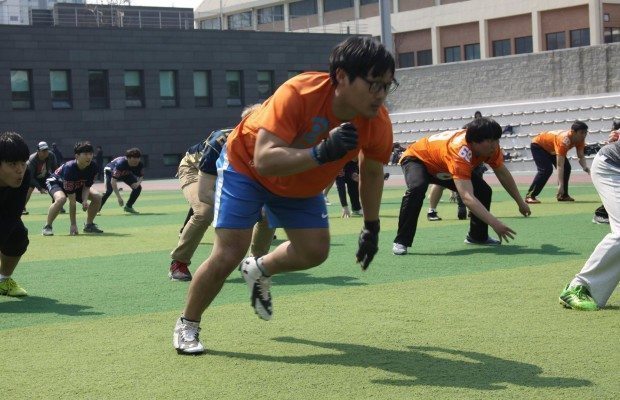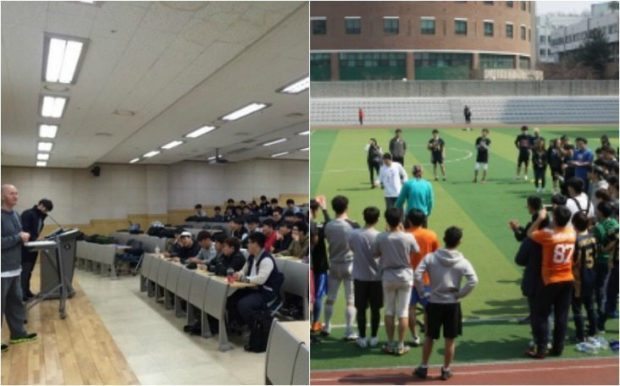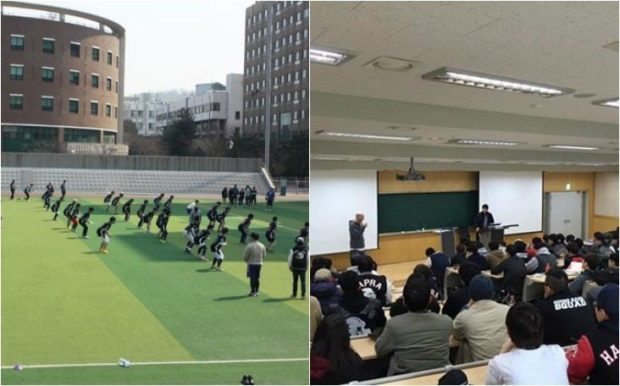Seoul Vikings, KAFA Host Highly Successful Coaching Clinic in Korea

American football is growing in South Korea. Randy Behr, a coach with the Seoul Vikings and the Korean American Football Association conducted a well attended “In-season conditioning and training session” at the University of Seoul last month and it drew outstanding numbers.
A total of six to seven university teams including coaches, managers and trainers turned out for the classroom and on-field clinic.
Here is his account of his highly successful session and an explanation of the methods he uses in coaching and training.
I opened up with a PowerPoint presentation that outlined periodization, program progressions, position and drill specific, general and specific dynamic warm-ups, proper usage of “speed ladders” and how to incorporate these effectively into your practice, speed and agility to include acceleration and deceleration specifics as well as special teams and “pursuit drills” conditioning.
With close to 100 individuals attending we were still able to get out and do the drills and techniques.
“The days of just going out and running to be running passed 20 years ago.”
For example, running “gassers, suicides, 100’s, lines” or whatever else they are called, is not specific or effective for a football player and probably not even for basketball and other sports.
The average play in football lasts about 3-5 seconds and covers only 5-17 yards depending upon the position, play, etc. Then, 20-30 seconds later (depending on the team, level, and organization) the cycle repeats .
Since there aren’t too many long runs at any level of football it doesn’t make sense to rep. “what you do.” Did you know only two running backs in the entire NFL last year had more than 10 20 + yard runs for the entire season!
The fact is only two running backs in the entire NFL last year had more than 10 20 + yard runs for the entire season!
Yes, I had to look at this twice.
Using special teams for conditioning
The clinic also worked on incorporating “Special Teams” as conditioning while working on technique and schemes too. For example, I do most of my special teams on the field sideways to cut down on the running enough to get “real work” and reps in. It also allows the players and coaches to be accountable and access themselves. The “white lines” hold them accountable to see if they are staying on track so to speak.
More specifically, on the kick-off team, it is very important for players to avoid contact while sprinting down the field. It is also important for them to get back into their lanes as quickly as possible if they do make contact with return team.
So, one way to work this is by using live bodies and line up 10 yards away and have them “figure 8” between the players. First, by avoiding, then “clubbing” and “ripping” or whatever combination the coach feels comfortable with and then getting back on the white lines. Once they get past the line of 3 or 4 players then the drills proceed with a breakdown. This is accomplished by “throttling” it down and “buzzing” the feet 5-7 yards away from the ball carrier(use a cone or a live player to simulate) and then proceed to the ball carrier. Everyone will converge on a cone/player creating triangles with players to the immediate left and right.
Once they get past the line of 3 or 4 players then the drills proceed with a breakdown. This is accomplished by “throttling” it down and “buzzing” the feet 5-7 yards away from the ball carrier(use a cone or a live player to simulate) and then proceed to the ball carrier. Everyone will converge on a cone/player creating triangles with players to the immediate left and right.
This is accomplished by “throttling” it down and “buzzing” the feet 5-7 yards away from the ball carrier(use a cone or a live player to simulate) and then proceed to the ball carrier. Everyone will converge on a cone/player creating triangles with players to the immediate left and right.
Does this make sense? It is also a great way to work with “edgers” on shuffling laterally once they get within 10-15 yards of ball carrier instead of running in a linear fashion, which will put them too deep and not allow them to converge on the ball carrier due to the speed they have worked up.
Speed and agility
Additionally, we worked on speed and agility in a scientific and progressive manner. In order to teach starts you need to address “force production” then you can work on acceleration and “top end” speed (although football rarely works on “top end” speed and only in certain special teams instances). Then in order to change directions deceleration must take place, which involves rapid movements of arms and legs coordinated together along with lowering of the hips to lower your center of gravity.
Training reaction
One of my favorite topics is reaction, as I believe it is the most underutilized component of sports and specifically football. I use them frequently and the three different forms routinely. The “Russians” believe this is a trainable skill and can increase by up to 25% by training it. I certainly tend to agree with this as well. The different ways to train and teach this are countless so I encourage coaches to be creative.
We also spoke about “conditioning” through defensive pursuit drills that can be accomplished in several different ways from the old days of having a “rabbit”, cones on sidelines to “3” plays in a row to the ball to simulate a series in football. Again, be creative and specific to your needs.
Position-specific movements
Lastly, we worked on “position-specific” movements for various positions on the field. For example, do you train the QB the same as the running back? Does the lineman move the same way as the Linebacker? How the about the receivers vs. the Defensive Backs? You get the point.
More specifically, I see so many coaches working with DB’s doing forward linear runs of 40 yards or more and think to myself how often in a game does this happen? Maybe much more suited drills would include the player in his stance working on different “route patterns” that he will encounter during the game such as a slant, out, dig, post, comeback, man, etc.
How about the linemen? They are one of my favorites as their movement patterns are very unique and have two distinct types; run blocking and pass blocking. Run blocking would consist on firing off the ball, down blocks, “scooping”, reaching, short-pull, long pull, etc. and require specific footwork so why not have them do this during conditioning. Then, pass blocking that consists of other patterns such as slide steps, kick outs, drop steps, etc. Or would you rather have them running 50-yard sprints?
As we wrapped up it was quite apparent that the Korean athletes and coaches were absorbing everything and had no problem running past the allotted time.

